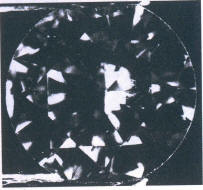Since September 1987 a new method of treatment has become known, by which inclusions in the cut diamond - and especially cracks which extend to the surface - can be made more transparent and hence less clearly discernible. Mr. Zvi Yehuda from Israel developed a method by which cracks are filled with a highly refractive liquid (presumably silicon oil) under strong pressure (50 atmospheres) and at temperatures of around 400°C. The is a process has been in use for many decades in the case of the oiling of cracked emeralds.
| A brilliant before and after treatment | |
|
|
|
| Fig 43 a Shows clearly a whitish cleavage crack | Fig 43 b Only the fine outline of the crack are still discernable |
Several brilliants were thoroughly examined and minutely inspected by the gemological Institute of America (GIA) both before and after treatment. In most cases it was found possible to upgrade brilliants in clarity grade from SI to VS. In the case of the pique grades the clarity grade remained for the most part unchanged. However the stones were more transparent, as milky air-filled cracks became more transparent due to the highly refractive liquid. This made the stones more marketable (Figs. 43 a and 43 b).
In the case of some stones the result of the treatment was that the color quality deteriorated by one grade. Perhaps the liquid with which the cracks are filled was of light-yellowish color.
Examination under the microscope at fairly high magnification showed small beads in the treated area. As a result of the fine liquid film in the crack planes some stones showed iridescent rainbows, which are extremely rare in diamonds.
Neither can the filling in the cracks withstand all the cutting and repair processes involved in jewelry work.
In any event the GIA does not issue expert opinions for stones which are treated in this fashion, as, unlike in the case of laser drilling, the durability of this artificial treatment cannot be guaranteed.
| Laser-drilled diamonds | Conditions of Clarity Grading |

